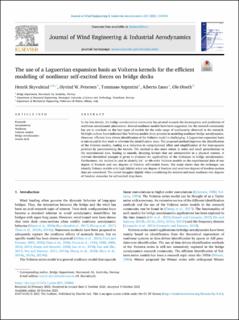| dc.contributor.author | Skyvulstad, Henrik | |
| dc.contributor.author | Petersen, Øyvind Wiig | |
| dc.contributor.author | Tomasso, Argentini | |
| dc.contributor.author | Zasso, Alberto | |
| dc.contributor.author | Øiseth, Ole Andre | |
| dc.date.accessioned | 2021-10-20T07:33:54Z | |
| dc.date.available | 2021-10-20T07:33:54Z | |
| dc.date.created | 2021-10-19T15:08:15Z | |
| dc.date.issued | 2021 | |
| dc.identifier.citation | Journal of Wind Engineering and Industrial Aerodynamics. 2021, 219, . | en_US |
| dc.identifier.issn | 0167-6105 | |
| dc.identifier.uri | https://hdl.handle.net/11250/2823990 | |
| dc.description.abstract | In the last decade, the bridge aerodynamics community has pivoted towards the investigation and prediction of nonlinear aerodynamic phenomena. Several nonlinear models have been suggested, but the research community has yet to conclude on the best types of models for the wide range of nonlinearity observed in the research. Multiple authors have indicated that Volterra models show promise in modeling nonlinear bridge aerodynamics. However, efficient data-driven identification of the Volterra model is challenging. A Laguerrian expansion basis is introduced in this work to alleviate the identification issue. The proposed method improves the identification of the Volterra models, leading to a reduction in computational effort and simplification of the least-squares problem by parameterizing the kernels. The method is also more robust to noise and small perturbations in the experimental data, leading to smooth, decaying kernels that are interpretable in a physical context. A relevant theoretical example is given to evaluate the applicability of the technique in bridge aerodynamics. Furthermore, the method is used to identify 1st− to 4th-order Volterra models on the experimental data of one degree of freedom and two degrees of freedom self-excited forces. The study shows that the technique can identify Volterra models with high fidelity when one degree of freedom and most two degrees of freedom motion data are considered. The model struggles slightly when considering the noisiest and most nonlinear two degrees of freedom scenarios for self-excited drag force. | en_US |
| dc.language.iso | eng | en_US |
| dc.publisher | Elsevier Science | en_US |
| dc.rights | Navngivelse 4.0 Internasjonal | * |
| dc.rights.uri | http://creativecommons.org/licenses/by/4.0/deed.no | * |
| dc.title | The use of a Laguerrian expansion basis as Volterra kernels for the efficient modeling of nonlinear self-excited forces on bridge decks | en_US |
| dc.type | Peer reviewed | en_US |
| dc.type | Journal article | en_US |
| dc.description.version | publishedVersion | en_US |
| dc.source.volume | 219 | en_US |
| dc.source.journal | Journal of Wind Engineering and Industrial Aerodynamics | en_US |
| dc.identifier.doi | https://doi.org/10.1016/j.jweia.2021.104805 | |
| dc.identifier.cristin | 1947098 | |
| dc.source.articlenumber | 104805 | en_US |
| cristin.ispublished | true | |
| cristin.fulltext | postprint | |
| cristin.qualitycode | 1 | |

